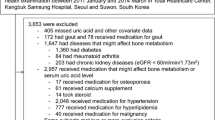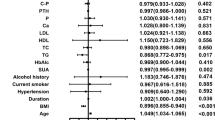Abstract
Summary
Higher serum uric acid (UA) was associated with higher bone mass, lower bone turnover, and lower prevalence of vertebral fracture in postmenopausal women. Furthermore, UA suppressed osteoclastogenesis and decreased production of reactive oxygen species in osteoclast precursors, indicating UA may have beneficial effects on bone metabolism as an antioxidant.
Introduction
UA is known to play a physiological role as an antioxidant, and oxidative stress has detrimental effects on bone metabolism. In the present study, we investigated the association of serum UA level with the osteoporosis-related phenotypes and its direct effect on bone-resorbing osteoclasts using in vitro systems.
Methods
This is a large cross-sectional study, including 7,502 healthy postmenopausal women. Bone mineral density (BMD) and serum UA concentrations were obtained from all subjects. Data on bone turnover markers and lateral thoracolumbar radiographs were available for 1,023 and 6,918 subjects, respectively. An in vitro study investigated osteoclastogenesis and reactive oxygen species (ROS) levels according to UA treatment.
Results
After adjusting for multiple confounders, serum UA levels were positively associated with BMD at all sites (all p < 0.001). Compared with the participants in the highest UA quartile, the odds for osteoporosis were 40 % higher in those in the lowest quartile. The serum UA levels were inversely related to both serum C-terminal telopeptide of type I collagen and osteocalcin levels (p < 0.001 and p = 0.004, respectively). Consistently, subjects with vertebral fracture had lower serum UA levels, compared with those without it (p = 0.009). An in vitro study showed that UA decreased osteoclastogenesis in a dose-dependent manner and reduced the production of ROS in osteoclast precursors.
Conclusion
These results provide epidemiological and experimental evidence that serum UA may have a beneficial effect on bone metabolism as an antioxidant in postmenopausal women.




Similar content being viewed by others
References
Jin M, Yang F, Yang I, Yin Y, Luo JJ, Wang H, Yang XF (2012) Uric acid, hyperuricemia and vascular diseases. Front Biosci 17:656–669
Holme I, Aastveit AH, Hammar N, Jungner I, Walldius G (2009) Uric acid and risk of myocardial infarction, stroke and congestive heart failure in 417,734 men and women in the Apolipoprotein MOrtality RISk study (AMORIS). J Intern Med 266:558–570
Feig DI, Kang DH, Johnson RJ (2008) Uric acid and cardiovascular risk. N Engl J Med 359:1811–1821
Choi HK, Ford ES (2007) Prevalence of the metabolic syndrome in individuals with hyperuricemia. Am J Med 120:442–447
Becker BF (1993) Towards the physiological function of uric acid. Free Radic Biol Med 14:615–631
Sautin YY, Johnson RJ (2008) Uric acid: the oxidant–antioxidant paradox. Nucleosides Nucleotides Nucleic Acids 27:608–619
Berry CE, Hare JM (2004) Xanthine oxidoreductase and cardiovascular disease: molecular mechanisms and pathophysiological implications. J Physiol 555:589–606
Duan X, Ling F (2008) Is uric acid itself a player or a bystander in the pathophysiology of chronic heart failure? Med Hypotheses 70:578–581
Landmesser U, Spiekermann S, Dikalov S, Tatge H, Wilke R, Kohler C, Harrison DG, Hornig B, Drexler H (2002) Vascular oxidative stress and endothelial dysfunction in patients with chronic heart failure: role of xanthine-oxidase and extracellular superoxide dismutase. Circulation 106:3073–3078
Chambers DE, Parks DA, Patterson G, Roy R, Mccord JM, Yoshida S, Parmley LF, Downey JM (1985) Xanthine-oxidase as a source of free-radical damage in myocardial ischemia. J Mol Cell Cardiol 17:145–152
Doehner W, Schoene N, Rauchhaus M, Leyva-Leon F, Pavitt DV, Reaveley DA, Schuler G, Coats AJ, Anker SD, Hambrecht R (2002) Effects of xanthine oxidase inhibition with allopurinol on endothelial function and peripheral blood flow in hyperuricemic patients with chronic heart failure: results from 2 placebo-controlled studies. Circulation 105:2619–2624
Waring WS, Webb DJ, Maxwell SRJ (2001) Systemic uric acid administration increases serum antioxidant capacity in healthy volunteers. J Cardiovasc Pharm 38:365–371
Bowman GL, Shannon J, Frei B, Kaye JA, Quinn JF (2010) Uric acid as a CNS antioxidant. J Alzheimers Dis 19:1331–1336
Paganoni S, Zhang M, Quiroz Zarate A, Jaffa M, Yu H, Cudkowicz ME, Wills AM (2012) Uric acid levels predict survival in men with amyotrophic lateral sclerosis. J Neurol 259:1923–1928
Garrett IR, Boyce BF, Oreffo RO, Bonewald L, Poser J, Mundy GR (1990) Oxygen-derived free radicals stimulate osteoclastic bone resorption in rodent bone in vitro and in vivo. J Clin Invest 85:632–639
Ha H, Kwak HB, Lee SW, Jin HM, Kim HM, Kim HH, Lee ZH (2004) Reactive oxygen species mediate RANK signaling in osteoclasts. Exp Cell Res 301:119–127
Bai XC, Lu D, Bai J, Zheng H, Ke ZY, Li XM, Luo SQ (2004) Oxidative stress inhibits osteoblastic differentiation of bone cells by ERK and NF-kappa B. Biochem Bioph Res Co 314:197–207
Park BG, Yoo CI, Kim HT, Kwon CH, Kim YK (2005) Role of mitogen-activated protein kinases in hydrogen peroxide-induced cell death in osteoblastic cells. Toxicology 215:115–125
Maggio D, Barabani M, Pierandrei M, Polidori MC, Catani M, Mecocci P, Senin U, Pacifici R, Cherubini A (2003) Marked decrease in plasma antioxidants in aged osteoporotic women: results of a cross-sectional study. J Clin Endocrinol Metab 88:1523–1527
Sánchez-Rodríguez M, Ruiz-Ramos M, Correa-Muñoz E, Mendoza-Núñez V (2007) Oxidative stress as a risk factor for osteoporosis in elderly Mexicans as characterized by antioxidant enzymes. BMC Musculoskelet Disord 8:124
Sontakke AN, Tare RS (2002) A duality in the roles of reactive oxygen species with respect to bone metabolism. Clin Chim Acta 318:145–148
Hall SL, Greendale GA (1998) The relation of dietary vitamin C intake to bone mineral density: results from the PEPI study. Calcif Tissue Int 63:183–189
Melhus H, Michaelsson K, Holmberg L, Wolk A, Ljunghall S (1999) Smoking, antioxidant vitamins, and the risk of hip fracture. J Bone Miner Res 14:129–135
Rao L, Mackinnon E, Josse R, Murray T, Strauss A, Rao A (2007) Lycopene consumption decreases oxidative stress and bone resorption markers in postmenopausal women. Osteoporosis Int 18:109–115
Mackinnon E, Rao A, Josse R, Rao L (2011) Supplementation with the antioxidant lycopene significantly decreases oxidative stress parameters and the bone resorption marker N-telopeptide of type I collagen in postmenopausal women. Osteoporosis Int 22:1091–1101
Lean JM, Davies JT, Fuller K, Jagger CJ, Kirstein B, Partington GA, Urry ZL, Chambers TJ (2003) A crucial role for thiol antioxidants in estrogen-deficiency bone loss. J Clin Invest 112:915–923
Donghui MM (2010) Moderate levels of plasma uric acid could promote fracture healing. Med Hypotheses 75:682
Cockcroft DW, Gault MH (1976) Prediction of creatinine clearance from serum creatinine. Nephron 16:31–41
Kiel D (1995) Assessing vertebral fractures. National Osteoporosis Foundation Working Group on Vertebral Fractures. J Bone Miner Res 10:518–523
Genant HK, Wu CY, van Kuijk C, Nevitt MC (1993) Vertebral fracture assessment using a semiquantitative technique. J Bone Miner Res 8:1137–1148
Yoneda M, Takatsuki K, Tomita A (1983) Parathyroid function and uric acid metabolism. Nihon Naibunpi Gakkai Zasshi 59:1738–1751
Hui JY, Choi JW, Mount DB, Zhu Y, Zhang Y, Choi HK (2012) The independent association between parathyroid hormone levels and hyperuricemia: a national population study. Arthritis Res Ther 14:R56. doi:10.1186/ar3769
Miller PD (2008) Safety of parathyroid hormone for the treatment of osteoporosis. Curr Osteoporos Rep 6:12–16
Takahashi S, Yamamoto T, Moriwaki Y, Tsutsumi Z, Yamakita J, Higashino K (1998) Decreased serum concentrations of 1,25(OH)2-vitamin D3 in patients with gout. Metabolism 47:336–338
Vanholder R, Patel S, Hsu CH (1993) Effect of uric acid on plasma levels of 1,25(OH)2D in renal failure. J Am Soc Nephrol 4:1035–1038
Nabipour I, Sambrook PN, Blyth FM, Janu MR, Waite LM, Naganathan V, Handelsman DJ, Le Couteur DG, Cumming RG, Seibel MJ (2011) Serum uric acid is associated with bone health in older men: a cross–sectional population–based study. J Bone Miner Res 26:955–964
Lean JM, Jagger CJ, Kirstein B, Fuller K, Chambers TJ (2005) Hydrogen peroxide is essential for estrogen-deficiency bone loss and osteoclast formation. Endocrinology 146:728–735
Hamidi MS, Corey PN, Cheung AM (2012) Effects of vitamin E on bone turnover markers among US postmenopausal women. J Bone Miner Res 27:1368–1380
Leveille SG, LaCroix AZ, Koepsell TD, Beresford SA, Van Belle G, Buchner DM (1997) Dietary vitamin C and bone mineral density in postmenopausal women in Washington State, USA. J Epidemiol Community Health 51:479–485
Jagger CJ, Lean JM, Davies JT, Chambers TJ (2005) Tumor necrosis factor-alpha mediates osteopenia caused by depletion of antioxidants. Endocrinology 146:113–118
Sritara C, Ongphiphadhanakul B, Chailurkit L, Yamwong S, Ratanachaiwong W, Sritara P (2012) Serum uric acid levels in relation to bone-related phenotypes in men and women. J Clin Densitom. doi:10.1016/j.jocd.2012.05.008
Makovey J, Macara M, Chen JS, Hayward CS, March L, Seibel MJ, Sambrook PN (2013) Serum uric acid plays a protective role for bone loss in peri- and postmenopausal women: a longitudinal study. Bone 52:400–406
Brown JP, Albert C, Nassar BA et al (2009) Bone turnover markers in the management of postmenopausal osteoporosis. Clin Biochem 42:929–942
Shin CS, Kim MJ, Shim SM et al (2012) The prevalence and risk factors of vertebral fractures in Korea. J Bone Miner Metab 30:183–192
Acknowledgments
This study was supported by a grant from the Korea Health Technology R&D Project, Ministry of Health & Welfare, Republic of Korea (project no.: A110536) and a grant from the Asan Institute for Life Sciences, Seoul, Republic of Korea (project no.: 2011–523).
Conflicts of interest
None.
Author information
Authors and Affiliations
Corresponding author
Electronic supplementary material
Below is the link to the electronic supplementary material.
ESM 1
(DOC 54 kb)
Rights and permissions
About this article
Cite this article
Ahn, S.H., Lee, S.H., Kim, BJ. et al. Higher serum uric acid is associated with higher bone mass, lower bone turnover, and lower prevalence of vertebral fracture in healthy postmenopausal women. Osteoporos Int 24, 2961–2970 (2013). https://doi.org/10.1007/s00198-013-2377-7
Received:
Accepted:
Published:
Issue Date:
DOI: https://doi.org/10.1007/s00198-013-2377-7




